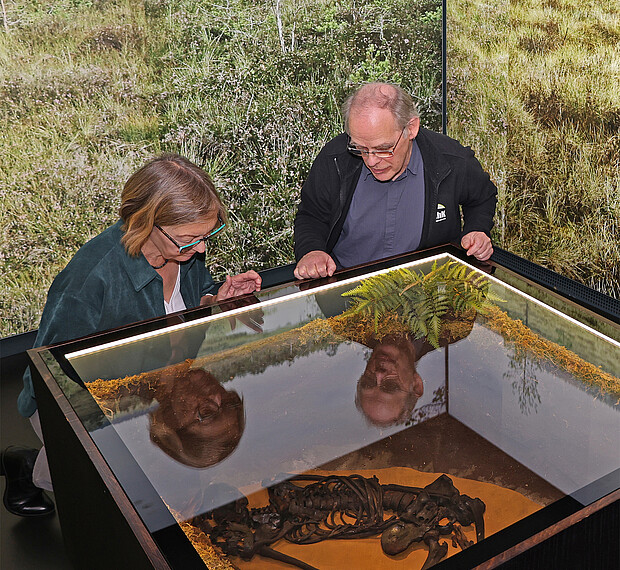Clothing and everyday life around 700 AD: the Bernuthsfeld Man



The burial site discovered in the bog near Tannhausen (Aurich district) dating from around 700 AD is unique: The deceased was buried fully clothed, wearing a long tunic reaching down to his thighs, foot bindings, and a large rectangular cloak, supplemented by other smaller pieces. His sheep's wool clothing is considered one of the best-preserved ensembles of early medieval clothing in Europe. In particular, his tunic, composed of dozens of fragments, has been the subject of much speculation since its discovery in 1907. Now, using the latest methods in the natural sciences and humanities, researchers aim to reconstruct who this man was, how he lived, where and when the fabrics were produced, and what significance his clothing had.
The three-year project “Quality and Sustainability around 700 AD: The Clothing of the Bernuthsfeld Man,” led by Prof. Dr. Hauke Jöns, is funded by the Lower Saxony Ministry of Science and Culture as part of the Pro*Niedersachsen funding program and supported by the art and culture association 1820dieKUNST, Emden, which is making this exceptional find available for the planned analyses.
The textile archaeological investigations at the NIhK will be conducted by Dr. Susan Möller-Wiering, supported by Dr. Katrin Struckmeyer, who is responsible for photographic documentation in the field of microscopy. Fascinating results are also expected from scientific analyses such as strontium isotope determination, dye and mordant analyses, and 14C dating of individual pieces; these are being carried out in cooperation with the Reiss-Engelhorn Museen and the Curt-Engelhorn-Zentrum Archäometrie, both in Mannheim. Fiber analyses and the examination of a textile fragment containing feathers are also of great importance; Dr. Sylvia Mitschke from the Reiss-Engelhorn Museen in Mannheim has been recruited for these tasks.
Other partners and supporters in this project are Jasmin Alley, M.A. (Ostfriesisches Landesmuseum in Emden), Dr. Annette Paetz gen. Schieck (Deutsches Textilmuseum in Krefeld) and Dr. Jan Kegler (Ostfriesische Landschaft in Aurich) and their respective institutions. The results will be compiled in a multimedia catalog and are intended to enrich not only research but also the museum presentation and communication of this outstanding cultural heritage.
References:
Farke 2001: H. Farke: A typical costume of the North German Iron Age? Some observations during conservation of the Bernuthsfeld 'plaid'. In: Penelope Walton Rogers, Lise Bender Jørgensen, Antoinette Rast-Eicher (Hrsg.): The Roman Textile Industry and its Influence – A Birthday Tribute to John Peter Wild. Oxbow Books (Oxford 2001), 129–136.
Heumüller / Kegler 2019: M. Heumüller, J. F. Kegler: Der Mann von Bernuthsfeld und seine Zeit. Die neue Ausstellung im Ostfriesischen Landesmuseum Emden. In: Berichte zur Denkmalpflege in Niedersachsen. Nr. 4, 2016, 178–184.
Mitschke 2021: S. Mitschke: Material und Verarbeitung textiler Rohstoffe in der römischen Epoche. dx.doi.org/10.15496/publikation-53211 .
Püschel u.a. (Hrsg.) 2019: K. Püschel, E. Jopp-van Well, W. Jahn, H. Hassmann u. M. Schulz (Hrsg.), „Bernie“ – Die Moorleiche von Bernuthsfeld. Ergebnisse der interdisziplinären Erforschung und Rekonstruktion eines frühmittelalterlichen Fundkomplexes aus Ostfriesland. Materialhefte zur Archäologie Niedersachsens 57 (Rhaden/Westfalen 2019).
Tidow 1995: K. Tidow, Textiltechnische Untersuchungen an Wollgewebefunden aus friesischen Wurtensiedlungen von der Mitte des 7. bis zur Mitte des 13. Jhs. und Vergleiche mit Grab- und Siedlungsbefunden aus dem nördlichen Europa. Probleme der Küstenforschung im südlichen Nordseegebiet 23, 1995, 353–387.
